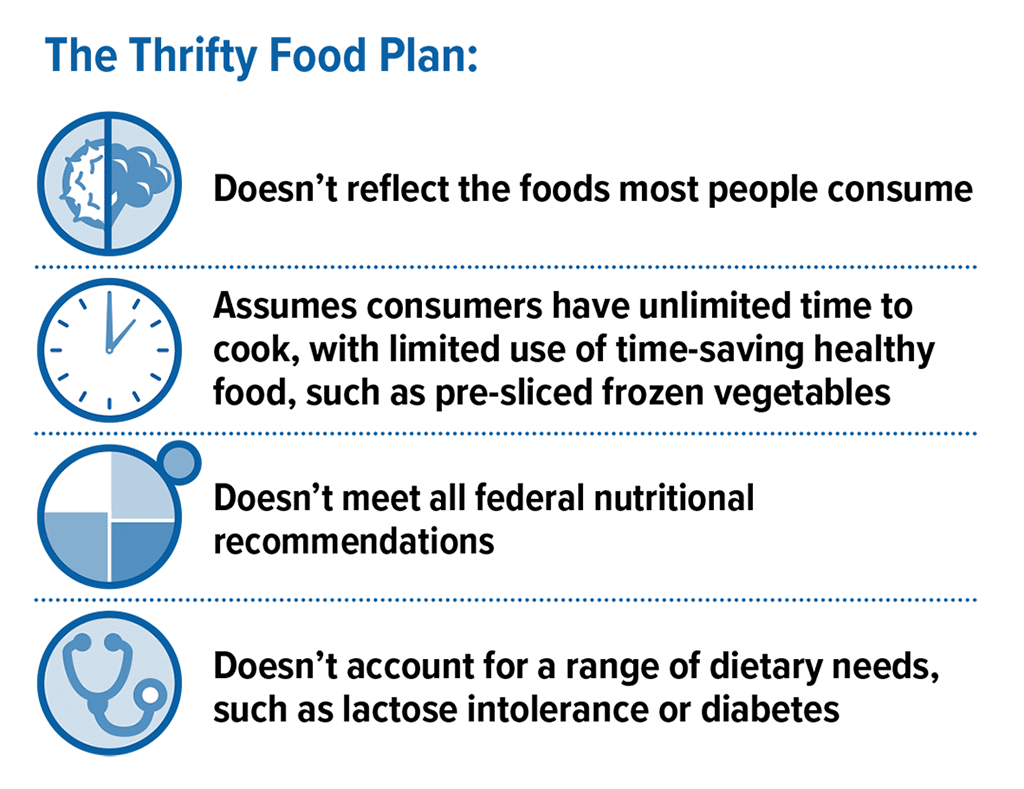
In late August, the Biden administration did something Congress told Pres. Trump to do three years ago, something that hadn’t been done in 45 years, something advocates had been wanting for decades: the USDA recalculated SNAP benefit amounts to better reflect what people need to spend nowadays to eat.
As anyone who got SNAP before the pandemic knows, the $4/day in food stamps for the average recipient isn’t much. It won’t help you get through the month on much more than ramen noodles and other cheap processed foods, if that. That’s why so many SNAP households have to rely on food banks and pantries towards the end of every month, especially when food prices increase.
The federal government never intended SNAP benefits to be a low-income household’s entire source of funding for food — the “S” stands for Supplemental. But benefit levels have been so low that they haven’t rescued many families, especially families of color, from food insecurity.
How the old Thrifty Food Plan worked – or didn’t
The Thrifty Food Plan (TFP) has been the federal government’s model for calculating how much money a family needs in order to put healthy food on the table. As the word “thrifty” implies, there is very little wiggle room in this model; the government expected SNAP recipients to spend as little as possible on food.
 Aside from outdated benefits amounts, there were a lot of outdated assumptions in the model, as this graphic shows. The old TFP assumed families ate an unrealistically large amount of certain foods that take a long time to prepare, such as five pounds a week of dried beans for a family of four.
Aside from outdated benefits amounts, there were a lot of outdated assumptions in the model, as this graphic shows. The old TFP assumed families ate an unrealistically large amount of certain foods that take a long time to prepare, such as five pounds a week of dried beans for a family of four.
It also assumed most SNAP families were two-parent households with only one parent working and the other at home. In that scenario, they budgeted a parent (presumably homemaker Mom) could spend up to two hours cooking each day.
But that was never truly the American norm. By 1960, only half of American children had a working father and stay-at-home mom (who hadn’t divorced), and far fewer do now. Plus wages have been so low in this country for so long that many families, particularly low-income ones, either need both parents to be employed or a single parent must work multiple jobs.
The former TFP’s model for eating habits was also outdated. It left out many healthy foods or only budgeted small serving sizes for them. It didn’t reflect more recent findings on the importance of whole grains, leafy green vegetables, lean proteins, and seafood for proper health. For example, it included less than a pound of eggs a week – roughly one large egg for an entire family of four per day.
The USDA’s aim with this update was to address all these problems
The new and improved Thrifty Food Plan
On average, the revised Thrifty Food Plan will boost pre-pandemic SNAP benefit levels by roughly 25%, or an extra $36.24 per person, per month. This is the largest increase in the program’s history.
The other thing that can help under-resourced families get healthy meals on the table is understanding that the typical working person nowadays spends under an hour, and sometimes less than 15 minutes, on meal preparation. So the benefit amounts in the revised TFP are based on a household food budget that incorporates healthier foods that take less time to prepare. That means more peeled or pre-sliced vegetables, ready-to-cook cuts of lean meat, and canned beans instead of dried.
What the new Thrifty Food Plan means for SNAP recipients
The increased benefit amounts go into effect starting October 1. You can see them in the chart on our Food Stamps Help page.
This increase replaces the 15% increase to benefits the Biden administration had put in place this spring, which expired Sep. 30. These new benefit amounts will also be reflected in the monthly SNAP Emergency Allotments, which are slated to continue through at least the end of 2021.
For example: a family of four who was eligible for $724 a month in SNAP benefits last month will now be eligible for $781 a month. The max SNAP they received of $782 last month due to the pandemic will now be $835 a month.
More resources on the Thrifty Food Plan
- 5 Details About the Largest Increase to SNAP Benefits in the Program’s History
- More Adequate SNAP Benefits Would Help Millions of Participants Better Afford Foods, (Center on Budget and Policy Priorities)




No comments yet.